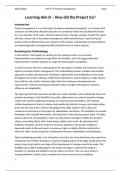Abdul Halim Unit 9: IT Project Management 2023
Learning Aim D – How did the Project Go?
Introduction
Project management is a crucial aspect of software development projects, as it ensures that
resources are efficiently allocated and tasks are completed within the specified time frame.
As a new member of the team, I had the opportunity to manage a project myself. This report
will take a closer look at the project management skills and behaviours I used during the
project and how effective they were. Based on this analysis, I will provide recommendations
for improving project management skills and behaviours for future projects.
Reviewing the Methodology
In this section, I will explain my strategy for the ordering system, its successful
implementation to complete my app within the deadline, and I will suggest potential
improvements to further optimize its usage for timely project completion.
In order to ensure that the ordering system for my project is reliable and functional, I have
opted to use Agile Project Management. This methodology involves a flexible and iterative
approach to project development, allowing for adjustments and modifications to be made
throughout the project's lifespan. Unlike linear approaches, where progress is made step by
step until the end result is achieved, Agile allows for continuous development and
improvement. Software development projects often use Agile techniques to maximize
efficiency and adaptability.
The Agile approach has numerous benefits over other methods, such as Waterfall. One of its
greatest advantages is the flexibility it provides. Agile teams can easily incorporate changes
without the need for additional meetings or revisions to documentation. This method
enables development teams to deploy code quickly by fixing the changes and incorporating
them into the next sprint. Another advantage of the Agile model is that it allows for
continuous involvement in the project by stakeholders and clients. This feedback can provide
developers with valuable information, allowing them to develop the project faster. The Agile
process allows for early feedback, which can help project managers simplify the iteration
phases, presenting clients with a basic design within a few weeks. By obtaining client
feedback, designers can then make the necessary updates to the project, leading to
improved results in the next sprint. In summary, Agile is a highly effective method that
allows for faster results and greater collaboration between stakeholders and developers.
Agile methodology provides a lot of benefits, but it also has some limitations that need to be
considered. One of these limitations is that the ongoing nature of the Agile model allows the
project team to go back to any stage of the development if changes need to be made. This
flexibility may make it challenging for the project manager to estimate the project's
duration, as changes and additions can be made at any time. This can cause delays in
meeting deadlines, which can be a problem for clients who have strict timelines.
1
, Abdul Halim Unit 9: IT Project Management 2023
Also, the lack of documentation in Agile methodologies can be a challenge for project
managers to implement. Documentation is an essential element of traditional project
management, and it provides reassurance and information about the progress of the project
to the project team. Without it, project managers may find it difficult to keep track of the
project's progress and communicate roles and responsibilities to their teams effectively.
Another limitation is scope creep, which occurs when the project team extends beyond the
requirements of the project beyond what was originally planned. This can result in spending
more money on the project than expected, which is not ideal for any organization. Agile's
flexibility makes it easy for project managers to fall into this trap, and the scope of the
project might not have been fully defined when the team started working on it.
If I couldn't use Agile, my next choice of methodology would be RAD (Rapid Application
Development). However, RAD has a downside of building the entire system at once, which
may cause delays in prototyping.
The Management Process
I finished making my prototype using Agile methodology, but some phases were more
successful than others. Overall, Agile was the right approach for me and I finished most of
the project without any problems. Using Agile allowed me to complete each phase quickly
and efficiently, without worrying about meeting deadlines. However, I found that I spent too
much time on the development stage and didn't focus as much on documentation, which
made it less interesting at the end. In my next project, I will make sure not to spend too
much time on prototyping and to focus more on documentation. Despite these challenges, I
was able to finish the project successfully and quickly, which was great for my first time
leading a project.
Job Roles
During the development of my app, I assigned various responsibilities to multiple people.
Despite being the main programmer, designer, manager, planner, and tester, I primarily
focused on programming and designing while delegating testing and feedback to others. The
restaurant funded the entire project, making it a reality. All of the project's responsibilities
were important, but I took the most crucial ones to ensure its success. Throughout the app's
development, I effectively fulfilled all of the assigned roles. One of the most significant
benefits of having a team was that everyone had a chance to share their thoughts during
testing and offer their unique opinions and suggestions for the app. This allowed me to
customize the app to their preferences. As the person in charge of the creative aspects of
the app, I was able to monitor its development and fix any issues that arose. However, the
delegation of responsibilities had some downsides, such as other team members being less
enthusiastic about the project due to an unequal allocation of tasks. In my next project, I will
make sure that everyone has an equal opportunity to contribute, and tasks are distributed
based on individual strengths. This will help manage the workload and keep team members
2




